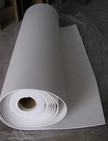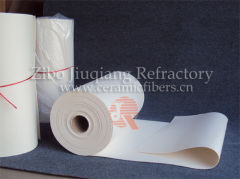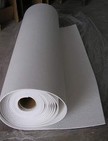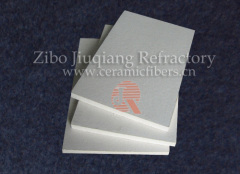
|
zibo jiuqiang refractory co., ltd.
|
ceramic fiber products
| Price: | 7.0~8.0 USD |
| Payment Terms: | T/T,L/C,D/A,D/P |
| Place of Origin: | Shandong, China (Mainland) |
|
|
|
| Add to My Favorites | |
| HiSupplier Escrow |
Product Detail
the paper can be widely used in building, glass industry for teeming pads separation. It provides maximum heat resistance and thermal insulation in l
Ceramic Fiber Paper
JIUQIANG ceramic fiber paper is manufactured from high-grade ceramic fiber with low slag ball content, and formed into excellent flexible sheet through unique beating, deslagging, slurry-compounding, long net forming, vacuum water removal, drying, cutting and rolling processes.
JIUQIANG ceramic fiber paper is manufactured from high-grade ceramic fiber with low slag ball content, and formed into excellent flexible sheet through unique beating, deslagging, slurry-compounding, long net forming, vacuum water removal, drying, cutting and rolling processes.
It is featured with high temperature resistance and heat insulation and high anti-melt capability, very low thermal conductivity, chemical corrosion resistance and thermal shock stability.
So the paper can be widely used in building, glass industry for teeming pads separation. It provides maximum heat resistance and thermal insulation in limited space.
So the paper can be widely used in building, glass industry for teeming pads separation. It provides maximum heat resistance and thermal insulation in limited space.
Product Advantages
1Easy to wrap, shape or cut
2Lightweight
2Lightweight
3 Low thermal conductivity; Low heat storage
4Contains no asbesto and anticorrosion
4Contains no asbesto and anticorrosion
5 Good uniformity and smooth appearance
6Good flexibility and toughness and resistance to avulsion
7Good dielectric strength and sound insulation
8 Excellent thermal shock resistance
9 Excellent chemical satability and machining property
10 Excellent corrosion resistance
Typical Application
00cut gaskets between castings in coke oven doors, blast furnace hot air piping, aluminium heat treating furnace, tuyeres and heat treat furnaces.
1Backup for brick and monolithic refractories in blast furnace stoves, piping, tundish, ladle, hot metal cars, trough etc.
2Mould wrapping for controlled cooling
3SEN isulation wraping
4Shield for welding & brazing operation
5Rotary klin back-up insulation
6Fabricated into tapout cones for Aluminium industry.
7Strips in bottom of ingot mould for sealing
8Expansion joint packing
9Induction coil liner
10Mould liner
11Silencer interleaf
12Ladle & tundish insulation
13Asbestos paper replacement
14Hot top linings
15Thermal and electrical insulation.
00Die cut gaskets between castings in coke oven doors, blast furnace hot air piping, aluminium heat treating furnace, tuyeres and heat treat furnaces.
00Backup for brick and monolithic refractories in blast furnace stoves, piping, tundish, ladle, hot metal cars, trough etc.
00Mould wrapping for controlled cooling
00SEN isulation wraping
00Shield for welding & brazing operation
00Rotary klin back-up insulation
00Fabricated into tapout cones for Aluminium industry.
00Strips in bottom of ingot mould for sealing
00Expansion joint packing
00Induction coil liner
00Mould liner
00Silencer interleaf
00Ladle & tundish insulation
00Ladle & tundish insulation
00Asbestos paper replacement
00Hot top linings
00Thermal and electrical insulation.
Die cut gaskets between castings in coke oven doors, blast furnace hot air piping, aluminium heat treating furnace, tuyeres and heat treat furnaces.
Backup for brick and monolithic refractories in blast furnace stoves, piping, tundish, ladle, hot metal cars, trough etc.
Mould wrapping for controlled cooling
Mould wrapping for controlled cooling
SEN isulation wraping
Shield for welding & brazing operation
Rotary klin back-up insulation
Fabricated into tapout cones for Aluminium industry.
Strips in bottom of ingot mould for sealing
Expansion joint packing
Induction coil liner
Mould liner
Silencer interleaf
Ladle & tundish insulation
Asbestos paper replacement
Hot top linings
Thermal and electrical insulation.
Technical Data
Grade | Standard | High Pure | High Aluminium | Zirconium | |||
Max. Temperature (℃) | 1050 | 1150 | 1260 | 1430 | |||
Shrinkage on Heating (%) | 800℃×24h≤-3 | 1000℃×24h≤-3 | 1280℃×24h≤-3 | 1400℃×24h≤-3 | |||
Organic Content (%) | ≤5 | ≤5 | ≤5 | ≤5 | |||
Thermal conductivity by mean temp. (W/m.k.) (250kg/m3) | 200℃ | 0.055~0.065 | 0.060~0.070 | ||||
400℃ | 0.110~0.120 | 0.105~0.125 | |||||
600℃ | 0.160~0.170 | 0.170~0.180 | |||||
Chemical Composition (%) | AL2O3 | 43 | 47 | 55 | 38 | ||
SiO2 | 53 | 51 | 44 | 44 | |||
Fe2O3 + Ti2O3 | ≤1.2 | ≤0.3 | ≤0.3 | ≤0.2 | |||
CaO + MgO | ≤0.3 | ≤0.3 | ≤0.3 | ≤0.2 | |||
NaO + KO2 | ≤0.5 | ≤0.3 | ≤0.3 | ≤0.2 | |||
Density (kg/m3) | 170~230 | ||||||
Size (mm) | Length: 60000/40000/30000/20000/15000/12000 Width: 1220/610 Thickness: 1~6 (Other sizes and shapes on request. ) | ||||||
Package | Carton box | ||||||
Certificates | ISO9001-2000; ISO14001-2000 | ||||||
Remarks: The data above is for reference. The Max. temp. depends on the working conditions.
Didn't find what you're looking for?
Post Buying Lead or contact
HiSupplier Customer Service Center
for help!
Related Search
Ceramic Fiber
Carbon Fiber Products
Ceramic Fiber Board
Ceramic Fiber Blanket
Ceramic Fiber Cloth
Ceramic Fiber Paper
More>>






